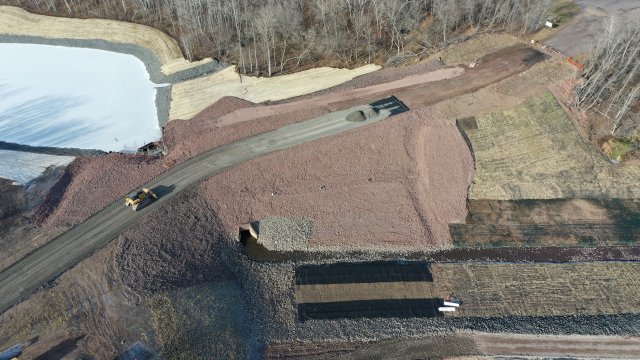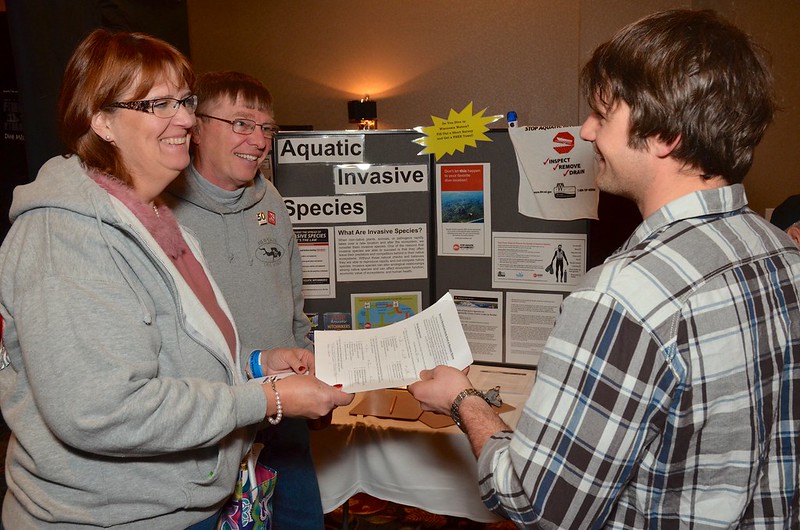An update on the Spirit Lake Great Lakes Legacy Act Project with Mark Loomis

What the Spirit Lake Great Lakes Legacy Act cleanup site looked in the winter of 2021-22. Image credit: U.S. Environmental Protection Agency
On Feb. 9, River Talks featured Mark Loomis, project manager for the Legacy Act Project at Spirit Lake on the St. Louis River in Duluth. Loomis presented an update, providing images and information on the remediation project’s status.
The Great Lakes Legacy Act (GLLA) is a voluntary program between the U.S. Environmental Protection Agency and U.S. Steel. Contractors from both organizations work to reduce the effects of contaminated sediments in Great Lakes Areas of Concern. These contaminants are large contributors to environmental degradation in the Great Lakes.
How does this work? Loomis shed some light on the process in the Spirit Lake project area. First comes removal. Mechanical excavation or hydraulic dredging removes the unwanted material, and then residual covers are placed over the sites. “That material is put into two on-site disposal facilities. Each of those facilities has a different method,” said Loomis, “Another mechanism that we’re using for remediation is called capping.” Capping is the act of placing protective layers of sand and carbon to stop contaminants from rising up through the water.
Other mechanisms include Enhanced Monitored Natural Recovery, which helps to speed up recovery, Monitored Natural Recovery, which simply observes recovery, and finally, habitat restoration. With this process, the integrity of Spirit Lake improves and habitat space for aquatic species increases.
Hydraulic dredging is a large focus of the Spirit Lake Project. “Hydraulic dredging in its simplest form is a cutter head that spins and eats up the sediment. It gets sucked through a series of pipes and pumps and is brought to a Geotube bag-field,” said Loomis. Dredging activities are currently taking place in the Wire Mill Delta. After the dredging is completed, the next step is to place a residual cover. “The residual cover water treatment plant takes clean material that is on the land, and we pump it through pipes in slurry. It’s then broadcast out to the spreader treatment plant.”
Despite working in his field for over a decade, Loomis still thought that seeing Geotubes get filled was “neat.” The pipe from the dredges goes through a series of treatment plants that prepare the contents for the Geotubes. These Geotubes run across the entirety of the upland confined disposal facility. Sediment remains inside of the Geotubes while the water runs out back into the lake.
With more and more Geotubes filling up and dewatering, the project staff plan to layer more on top. When the field is complete, it should stand about four Geotubes high.
The Legacy Act also focuses on upland habitat restoration. Loomis highlighted a specific upstream portion of land near Spirit Lake where native plants were planted last year. “We were in a constant mental and physical battle with geese and deer who saw this as a delicious buffet,” Loomis said. Despite the feud with wildlife, Loomis reported that the process is going well.
Loomis gives a more comprehensive list of past progress to date during his presentation, which is available online. To watch a video of this presentation, visit the Lake Superior Estuarine Research Reserve’s YouTube site.
For more information on the series, visit the River Talks page: go.wisc.edu/4uz720.
The post An update on the Spirit Lake Great Lakes Legacy Act Project with Mark Loomis first appeared on Wisconsin Sea Grant.
Blog | Wisconsin Sea Grant
https://www.seagrant.wisc.edu/blog/an-update-on-the-spirit-lake-great-lakes-legacy-act-project-with-mark-loomis/?utm_source=rss&utm_medium=rss&utm_campaign=an-update-on-the-spirit-lake-great-lakes-legacy-act-project-with-mark-loomis

